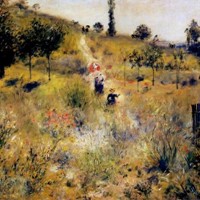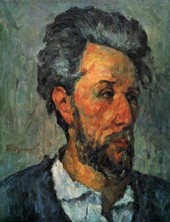|
IMPRESSIONISM
OUTDOORS
For a review of outdoor scenic
works, see Landscape Painting,
and the French
Barbizon School.
For a review of Impressionism
and plein-air art, see:
Impressionist
Landscapes.
IMPRESSIONISM & PORTRAITS
For information and examples
of portraiture, please see:
Impressionist Portraits.
PAINTING
For more about the evolution
of oils, acrylics, watercolours
and other types of paintings,
as well as famous artists, see:
Fine Art Painting.
MEANING OF ART
For a discussion of the types,
values, and significance of the
visual arts, see: Definition of Art.
WORLD'S GREATEST
ARTWORKS
For a list of the Top 10 painters/
sculptors: Best Artists of All
Time.
WORLD'S TOP PAINTERS
For details of the best
modern painters, see:
Famous Painters.
BEST IMPRESSIONIST
ART
The best collection of Impressionist
and Post-Impressionist paintings
hangs in the Musee d'Orsay Paris.
|
The Impressionist
painters themselves are far from Paris, isolated and settled more
permanently to paint and develop their work. Sisley
is at Saint-Mammes, near Moret and the Loing Canal. Monet
is at Givemy near Vemon, in the Eure, with the widow of Hoschede, who
is to become his second wife (Camille died in 1878, worn out by privation
and difficulty). Pissarro
has settled at Eragny, in the heart of the Vexin. Cezanne
most often lives at Aix where his family life finally became stable, excepting
the death of his father, by his marriage to Hortense Fiquet. He works
in the solitude of his property Jas de Bouffan. Only Renoir
pursues a different sort of life, spending ten years as a sort of mental
and physical vagabond before finally choosing the Mediterranean coast
as the setting and model for the Eden which blossoms out of his creation.
But even so it must not be thought that
the painters have completely withdrawn into themselves. Some bitter ideas
in the minds of some of them cannot make them forget that their solidarity
remains deep, and that friendship continues to keep them together to a
varying extent. They visit one another in their travels and sometimes
spend long periods at each other's homes. Renoir goes a number of times
to Cezanne's place (in 1882, 1883, 1888 and 1889), once accompanied by
Monet, and Cezanne in turn visits Renoir at La Roche-Guyon and Monet at
Giverny. Later strong ties link their children, but they are already like
part of the same family. They exchange ideas and experiences, and so much
the better if these do not agree. They attach the greatest importance
to opinions formulated on their own works.
They remain bound by what they have lived through and helping those of
them who have passed on. For more on the subject of their artistic aims,
see: Characteristics of Impressionist
Painting 1870-1910.
Monet's efforts ensure the success of a
subscription opened to purchase Manet's "Olympia" and offer
it to the Luxembourg Museum in 1890. In the same way Renoir, executor
of the will of Gustave
Caillebotte, succeeds in overcoming the reservations of the Fine Arts
Administration and having them accept (although sadly only thirty-eight
out of sixty-seven paintings) the legacy of this magnificent collection
to the State. In 1895 it is the insistence of Pissarro which persuades
Vollard to organise the first Cezanne exhibition, which in one showing
reveals the gigantic stature of the painter.
But preoccupied with the completion of their own personal works in their
remaining years of life, the painters are indifferent to new research
and the younger personalities who appear alongside them and by whom they
may soon be regarded as outshone. But we shall see in the latter part
of this work how Cezanne, Degas, Renoir and Monet survive their immediate
successors and how their work, after having sometimes been regarded as
anachronistic and outdated, keeps an unsurpassed presence and strength
and, after years of eclipse, a surprising up-to-dateness.
Only Pissarro, always generous and enthusiastic, keeps in touch with the
painters of the new generation who come to the fore after 1880. It is
he who fosters the late-developing vocation of Gauguin
and gives him all his help as Gauguin develops from a week-end painter
and collector to a detested artist. Gauguin comes to work alongside him
in Rouen in 1883. Pissarro becomes interested shortly afterwards in Georges
Seurat who, with all the conviction and ardour of a tyro, devotes
himself to giving a rigorous scientific base to the victories of Impressionism
and who, in 1884, founds with a group of artists rejected by the Salon
a new association of "Independents", in which each may exhibit
freely without submission to a jury. Pissarro meets him in 1885, as well
as Signac, who has asked Chevreul to amplify his interpretation of the
laws which the Impressionists have applied more or less scientifically.
Considering this more precise formulation to be a step forward, Pissarro
does not hesitate to adhere to the system drawn up by the younger men.
He decides to exhibit with the Independents and puts Seurat and Signac
into the last showings by the Impressionist group, which take place in
1886.
In fact at the time when Durand-Ruel is attempting his New York exhibition,
Berthe Morisot believes
it would be appropriate to show the importance of Impressionists as a
group in a parallel exhibition in Paris. Pissarro, who alone had taken
part in all the previous showings, asked to be allowed to exhibit with
his new friends. Monet, followed by Renoir, Caillebotte and Sisley, preferred
then to withdraw and take part in the International Exhibition organised
at the same time by Georges Petit. Thus was the final exhibition of the
Impressionist group dominated by Pissarro and through him it opened the
way to the future. He showed twenty canvases in his new style and Seurat's
composition "La Grand-Jatte" and his Grandcamp landscapes caused
a sensation. Seurat and Signac had been accepted by Durand-Ruel for the
New York exhibition. The publication by Felix
Feneon of an important article The Impressionists in 1886, which announced
the passing of Impressionism and took the side of Seurat and Signac, for
whom the critic invented the name "Neo-Impressionism",
marked an important turning point.
|


